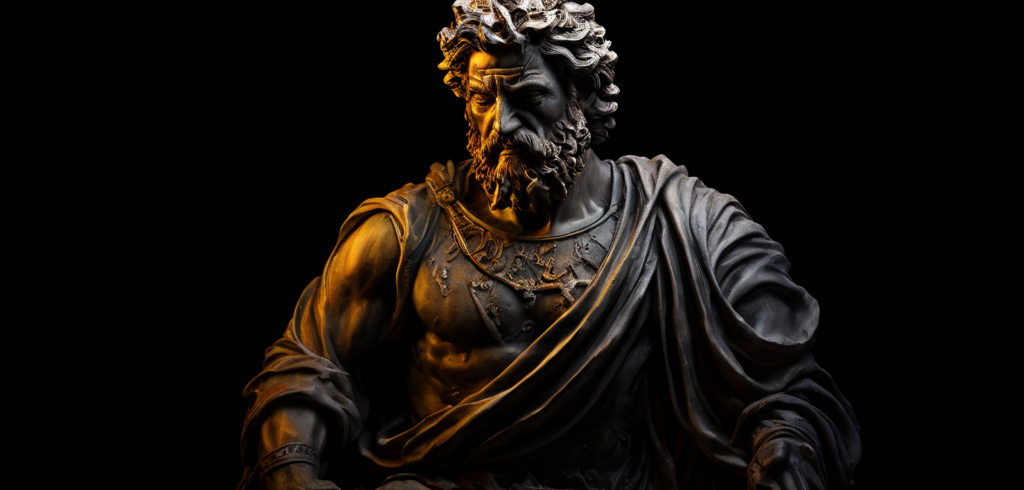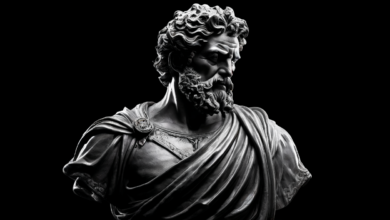The Inner Journey Uncovering Happiness through Stoicism
Introduction
In a world where the search for happiness is relentless and often seems elusive, the wisdom of the ancient Stoic philosophers offers a unique and timeless approach. “The Journey Within: Uncovering Happiness Through Stoicism” is a narrative that takes us on an exploration of the core principles of Stoicism and how they can be applied to the search for true happiness. This is not just a story, but a practical guide to living a more balanced, meaningful, and, above all, happy life.

Sofia’s Awakening
Sofia sat on the edge of her bed, staring at the white wall of her apartment. The silence of the night was broken only by the distant sound of traffic and the ticking of the clock on her bedside table. At thirty-two, she had everything society considered necessary to be happy: a successful career, an apartment in the city, influential friends, and an active social life. Yet a feeling of emptiness persisted, a restlessness she could not explain.
He stood up and walked over to the bookshelf, running his fingers along the spines of the books he had collected over the years. Novels, biographies, self-help books, all read and forgotten. It was then that his eyes fell on an old, leather-bound volume he had bought at a second-hand bookstore months ago. “Meditations” by Marcus Aurelius. Without knowing exactly why, he decided that this would be his evening’s reading. He opened the book and began to read. The philosopher-emperor’s words resonated within her, as if they had been written for her current situation. Marcus Aurelius was talking about the search for inner peace, the importance of living in accordance with nature, and the impermanence of all things. Sophia felt an immediate connection to his ideas. For the first time in a long time, she felt as if she had found something that could truly make a difference in her life. In the days that followed, Sofia immersed herself in reading the Stoic philosophers. She read Seneca, who taught her about the art of living and the importance of appreciating each moment. She studied Epictetus, who guided her in understanding that happiness does not lie in external circumstances, but in the way we perceive and react to them. Each page she turned, each idea she absorbed, seemed to illuminate a little more the path she was beginning to follow. Sophia realized that her search for happiness had, until then, been focused externally. She had believed that by achieving certain goals and possessing certain things, she would find the satisfaction she so desired. But now, with the wisdom of the Stoics, she began to understand that true happiness came from within, from a mind at peace and a heart in harmony with nature. She then decided that she would apply the Stoic principles to her life. She began to practice self-discipline, to control her emotions, and to focus on what she could control. She learned to accept the things she could not change and to focus her energy on the things she could. This new approach brought her an inner peace that she did not know was possible.
Seneca’s Wisdom – Happiness as an Art
Sofia was inspired by Seneca’s words. The Roman philosopher taught that happiness was an art to be cultivated, not a destination to be achieved. She began to see life as a journey, not a race to an end goal. Seneca had spoken about the importance of living in accordance with nature, of accepting mortality, and of appreciating the simple things in life.
Sophie decided that she would live by these principles. She began to spend more time outdoors, appreciating nature. She walked in the park, looking at the trees and birds, and feeling the wind on her face. These simple experiences brought her a joy she had not experienced in a long time.
She also began to practice meditation, following Seneca’s teachings on the importance of personal reflection. Meditation helped her calm her mind and find inner peace. Sophie realized that by controlling her thoughts, she could control her emotions and, consequently, her happiness.
Seneca also taught about the importance of accepting mortality. Sofia reflected on this idea and realized that by accepting the finiteness of life, she could value the present more. She decided that she would live each day as if it were her last, appreciating each moment and not worrying excessively about the future. This new perspective gave her a sense of freedom. Sofia felt lighter, happier. She realized that happiness was not a goal to be achieved, but a way of living. Happiness was the art of appreciating the present, of living in accordance with nature, and of accepting the impermanence of life.

Epictetus and the Power of Perception
Sophia continued her journey of self-discovery, now guided by the words of Epictetus. The Stoic philosopher taught that happiness lies not in external circumstances, but in the way we perceive and react to them. Sophia began to understand that she had the power to control her perceptions and, consequently, her happiness.
She began to practice mindfulness, focusing on the present and observing her reactions to the events around her. Sophie realized that she often overreacted to situations that, in retrospect, weren’t as serious as they seemed.She learned to control her emotions and respond more rationally.
Epictetus also taught about the distinction between what we can and what we cannot control. Sophie thought about this idea and realized that many of her worries were about things she couldn’t change. She decided that she would focus her energy on the things she could control and accept the things she couldn’t.
This new approach brought her an inner peace she didn’t know was possible.Sofia felt freer, happier.She realized that happiness was not a matter of circumstances, but of perception.Happiness was the ability to see the good side of things, to accept reality and to respond in a positive way.
Marcus Aurelius and the Inner Search
Sofia discovered the meditations of Marcus Aurelius, which guided her in the search for inner peace. The philosopher-emperor taught that true happiness comes from within, from a mind at peace and a heart in harmony with nature. Sophia began to understand that happiness was a matter of state of mind, not external circumstances. She began to practice self-discipline, following Marcus Aurelius’ teachings on the importance of personal reflection. Sophia began to take time to reflect on her actions and thoughts, always seeking to improve herself. She realized that by controlling her thoughts, she could control her emotions and, consequently, her happiness. Marcus Aurelius also taught about the importance of living in harmony with nature. Sophia reflected on this idea and realized that by living in harmony with nature, she could find inner peace. She decided that she would live a simpler life, appreciating the simple things in life. This new perspective brought her a sense of freedom. Sophia felt lighter, happier. She realized that happiness was not a goal to be achieved, but a state of mind to be cultivated. Happiness was the ability to live at peace with oneself, to accept reality, and to respond positively.

Accepting Impermanence
Sophia faced the reality of impermanence and learned to accept change as an inevitable part of life. She realized that much of her distress stemmed from fear of change and uncertainty about the future. Sophia decided that she would embrace change as an opportunity for growth.
She began to practice acceptance, following the teachings of the Stoic philosophers about the importance of accepting reality. Sofia realized that by accepting the things she could not change, she could focus her energy on the things she could. This new approach brought her an inner peace she did not know was possible.
Sofia also learned to appreciate the present, to value each moment as unique and precious. She realized that life is made up of moments, and that each one is a gift. This awareness gave her a new perspective, a different way of seeing the world.
Accepting impermanence did not mean resignation or apathy. On the contrary, Sofia felt more motivated to live life to the fullest, to make the most of every opportunity. She discovered that by embracing change, she could face challenges with more resilience and courage.

Virtue as the Path to Happiness
As Sophia applied Stoic principles to her life, she realized that virtue was the key to a happy life. The words of Seneca, Epictetus, and Marcus Aurelius on the importance of integrity, justice, courage, and wisdom resonated deeply with her. Sophia recognized that acting virtuously was not only morally right, but also essential to personal fulfillment.
She began to practice virtue in her daily life. At work, she worked hard to be fair and honest in her interactions. With friends and family, she became more compassionate and empathetic. Sofia also worked to develop her courage by facing her fears and taking calculated risks.
As Sofia lived her life according to virtue, she felt more fulfilled and happy. The happiness she experienced was not a superficial happiness, but a deep and lasting satisfaction. She realized that virtue was the foundation of a fulfilling and meaningful life.
Sofia also noticed that virtue strengthened her relationships.The people around her felt closer and appreciated.Virtue was contagious, and Sofia found herself inspiring others to live more virtuously.
Stoicism in Everyday Life
Sofia began to apply Stoic principles to her everyday life.She learned to deal with stress at work, to cultivate deeper relationships, and to find satisfaction in the little things. Stoicism became an integral part of her life, a practical philosophy that guided her actions and decisions. At work, Sofia faced challenges calmly and rationally. She stayed focused on her goals and priorities, avoiding distractions and distractions. The discipline she applied to her daily life was reflected in her work. Sofia became more productive and efficient, and her colleagues noticed her change in attitude. At home, Sofia also noticed changes. Little irritations, like a noisy neighbor or slow traffic, no longer affected her as much as they used to. She learned to accept the things she couldn’t change and focus her energy on the things she could control. This new perspective brought her an inner peace she didn’t know was possible.
Sofia began to see the world differently. Instead of focusing on the negative aspects, she began to look for the good in situations. This shift in perspective not only improved her mood, but it also strengthened her relationships. People around her noticed the difference, and Sofia felt more connected and appreciated.
Resilience in the Midst of Adversity
Sofia faced personal challenges that tested her faith in Stoic philosophy. She lost a loved one, struggled with health issues, and struggled financially. But instead of giving in to despair, Sofia remembered the Stoic lessons of resilience.
She learned to accept adversity as a part of life. Instead of resisting suffering, she embraced it as an opportunity for growth. Sofia discovered that by facing her challenges with courage and determination, she could turn them into sources of strength and wisdom. The resilience that Sofia developed allowed her to overcome obstacles and emerge stronger. She realized that adversity was an inevitable part of life, but that it did not have to define her. Resilience was a choice, a way of living that could be cultivated and practiced.
Sofia also learned to appreciate the little things, to appreciate the moments of joy and beauty that still existed in her life. She discovered that resilience was not just about enduring suffering, but also about finding hope and meaning in the midst of adversity.

Community and Purpose
Sofia discovered that true happiness was also linked to service to others and contributing to the community. She began to volunteer, helping those who were in vulnerable situations. This experience enriched her life in ways she had not expected.
Sofia felt more connected and fulfilled. She realized that by helping others, she was also helping herself. The community became a source of inspiration and purpose. Sophie discovered that a sense of purpose was an essential part of a fulfilling life.
She also realized that community was an important part of Stoic philosophy.The Stoics believed that we were all part of a global community, and that we had a duty to contribute to the common good.Sophie was inspired by this insight, and decided that she would live by these principles.
As Sofia applied Stoic principles to her life, she realized that community was an essential part of a fulfilling life. She discovered that by connecting with others and working together toward a common goal, she could find a sense of purpose that went beyond herself. This connection to community brought her a new dimension of meaning and fulfillment.
Sofia began to organize regular get-togethers with friends and colleagues to discuss philosophy and share experiences. These gatherings became a safe space for reflection and personal growth. Sofia felt part of something larger, a community of people seeking wisdom and virtue. She also began writing about her experiences and insights, sharing her reflections on a blog. Sofia hoped that her words would inspire others to seek Stoic wisdom and find their own path. Personal Legacy and the Art of Living
As time passed, Sofia felt that her Stoic journey had not only transformed her internally, but had also driven her to leave a positive mark on the world. She realized that the art of living was not a final destination, but an ongoing process of learning and growth. Each day presented new opportunities to practice virtue, to exercise wisdom, and to contribute to the well-being of others.
Sofia decided that she wanted to share her journey and the lessons she had learned with a wider audience. She began writing a book, not just as a personal account, but as a guide for those who, like her, were seeking a more meaningful and happy life. The book, titled “The Journey Within: Unlocking Happiness Through Stoicism,” became a synthesis of her experience and the Stoic teachings that had so influenced her.
In the process of writing, Sofia reflected deeply on her legacy. She wanted her work to inspire others to seek true happiness, not through the accumulation of material possessions or social recognition, but through personal development and community connection. Sofia believed that by sharing her story, she could help others find their own path to personal fulfillment. In addition to writing, Sofia also began giving lectures and workshops on stoicism and happiness. She traveled to different cities, sharing her ideas and listening to other people’s stories. These experiences enriched her understanding of the human condition and reinforced her belief in the universality of Stoic principles.
Sofia also continued to practice virtue in her daily life. She became involved in community projects, volunteered at local shelters, and participated in environmental sustainability initiatives. Through these actions, Sophia felt that she was living by Stoic principles, contributing to the common good and finding a sense of purpose that went beyond herself.
However, Sophia knew that the journey did not end there. She recognized that there was still much to learn and that the search for wisdom was a never-ending path. But this realization did not discourage her; on the contrary, it filled her with enthusiasm and hope. Sofia was grateful to have found a philosophy that not only helped her overcome her personal challenges, but also offered her a path to a full and meaningful life.
Conclusion
“The Journey Inward: Uncovering Happiness through Stoicism” culminates with Sophia in a state of contentment and fulfillment.She has not only transformed her own life, but has also inspired others to pursue wisdom and virtue.Sophia’s story is a testament to the transformative power of Stoic philosophy and how it can be applied in modern life to promote happiness and well-being.
The narrative ends on a note of hope, encouraging readers to embark on their own journey of self-discovery.Sofia reminds us that happiness is not a final destination, but a state of mind that can be cultivated through the constant practice of virtue, the acceptance of impermanence, and the pursuit of wisdom.
Tags: happiness, legacy, modern life, purpose, resilience, self-discovery, stoicism, wisdom, virtue



